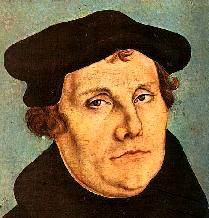
Maria as a modern day Martin Luther
I thought Martin Luther was a African American civil rights leader! Click Here
The Sound of Music can also be seen as a reference to the Reformation. The Reformation began with someone leaving a monastery, as does this film. In both cases the motivation for leaving is a conviction that God's grace cannot be confined to a religious institution, but must be expressed in the midst of the world. She becomes a governess, and changes the family’s point of view towards music and affection. She is appalled at their oblivion to the problems with the structure and the old fashioned, outdated ways of their own family, and educates them about a better life. This could represent how Luther changed many Catholic people’s minds and converted them to Lutheranism. He endured a journey from a lawyer to a monk, to a rebel to a ecclesiastical reformer, as Maria went from nun to employee, friend, mother figure and eventually, lover.


The popular song “My Favorite Things,” can also be interpreted in the context of the Reformation. When the children are upset by a storm, Maria is the healer, the dispeller of the dark shadows of grief. When the children confess their fear and rush to her bed, she teaches them a new habit of hope, in the form of a new song. More specifically, she teaches them that music has the power to dispel demons. When assailed by terrors like dog bites and bee stings, one has to call to mind one's favorite things, such as raindrops on roses, whiskers on kittens, and brown paper packages tied up with string. Although hidden behind feminine imagery, this song has a primitive base. It is exorcistic. Music has the power to expel evil forces. Maria is teaching them not just a new song but a repeatable liturgical practice. She is teaching them religious hope by means of art, self-expression, not an approved practice in Catholicism or the Von Trapp household.
Martin Luther
However, Maria is not completely separate from her roots, as Protestantism is not entirely distinct from Christianity. When she realized her love for the Captain, she flees to the abbey, and returns to her Catholic identity of a nun. Also, when she finally married the Captain at the end, the wedding takes place in the church of Maria’s old nunnery. She cannot sustain her independence from the church. This is symbolic to the fact that although the Protestant Church deviates from the Catholic Church on many issues, it still depends on its predecessor for many things, such as the initial following of Christianity. They share many of the same views, such as worshiping the same God, and reading many of the same scriptures. As Catholicism is a base for Protestantism, the nunnery is a base for Maria. Maria’s plight and that of her new family draw strong ties to the life of Martin Luther and Protestantism.
